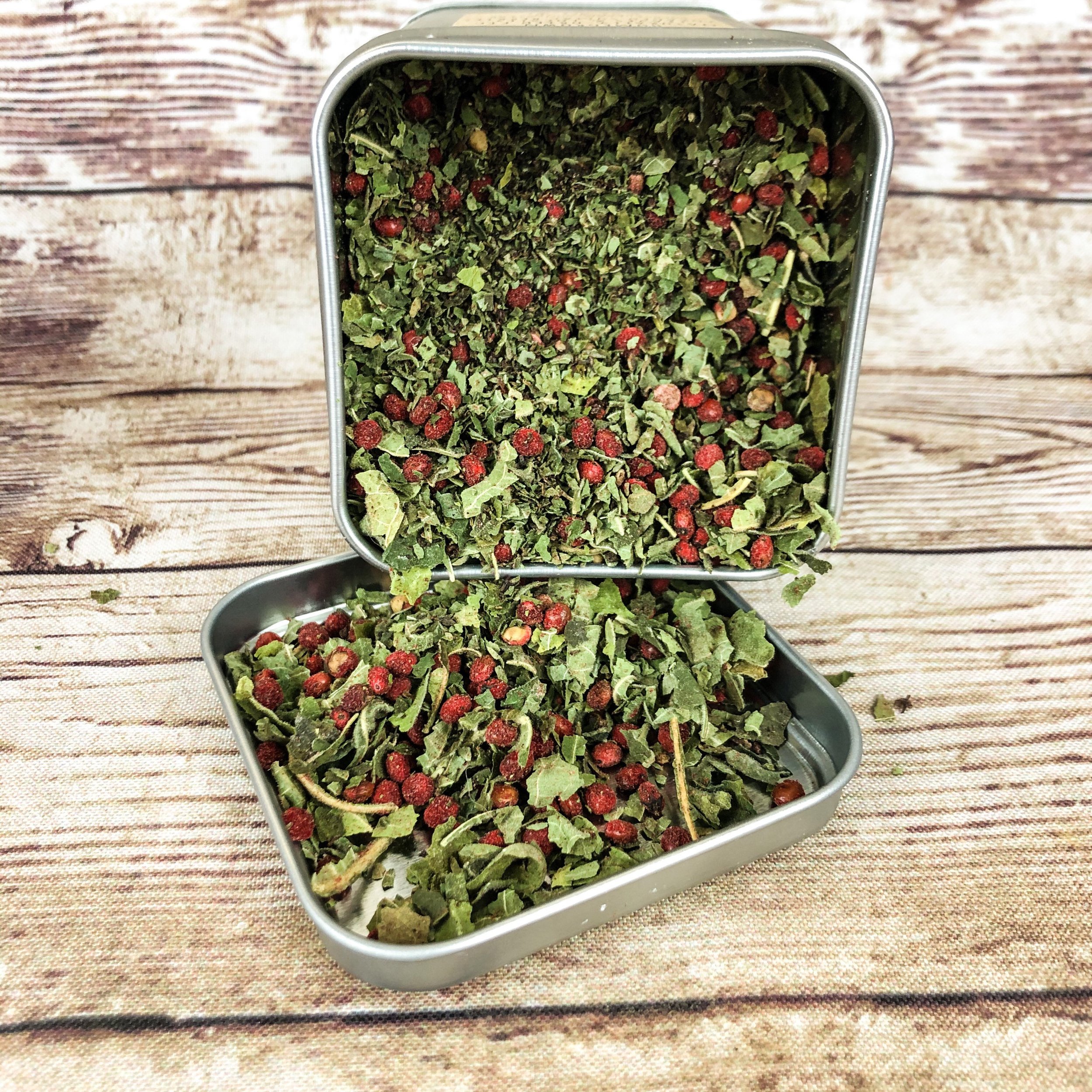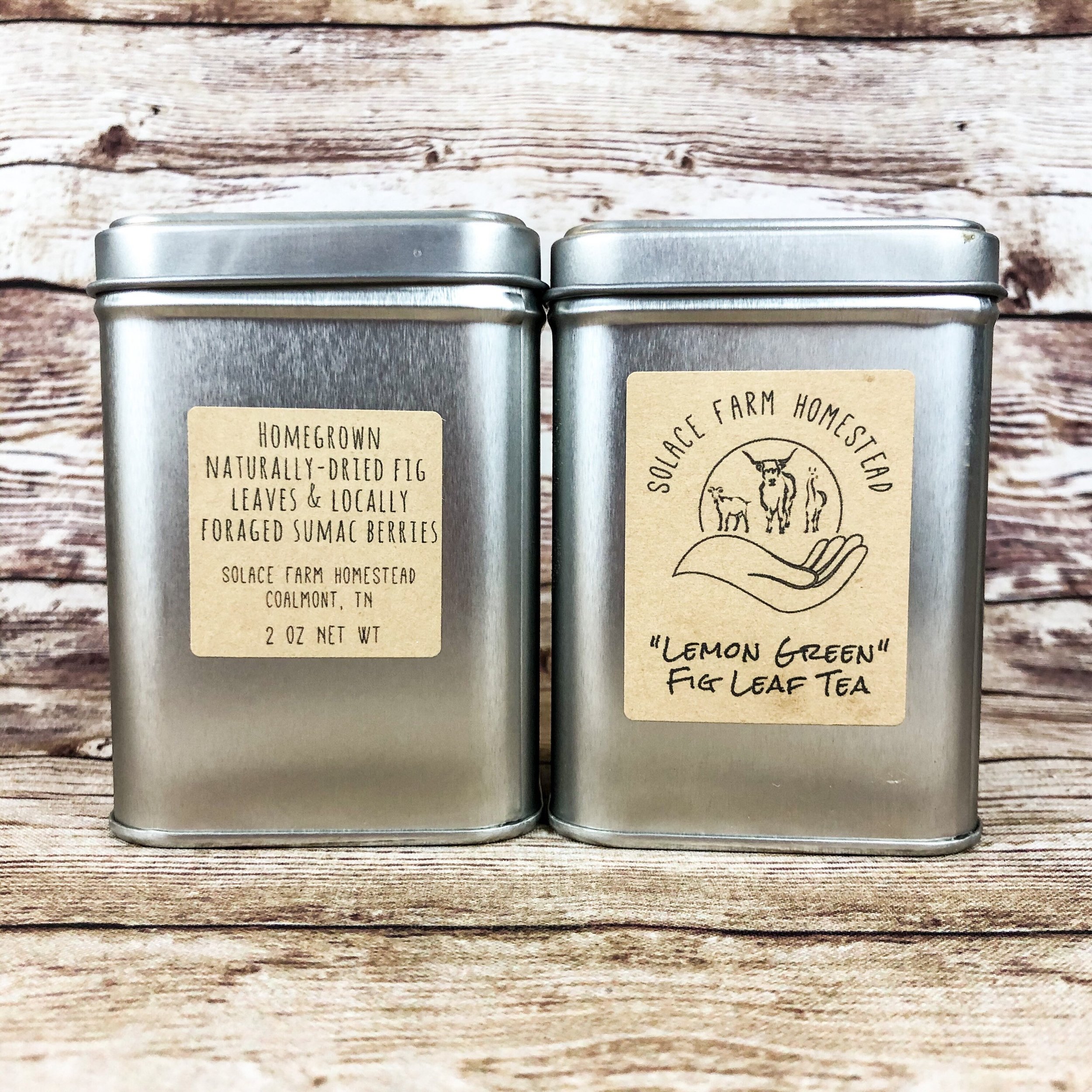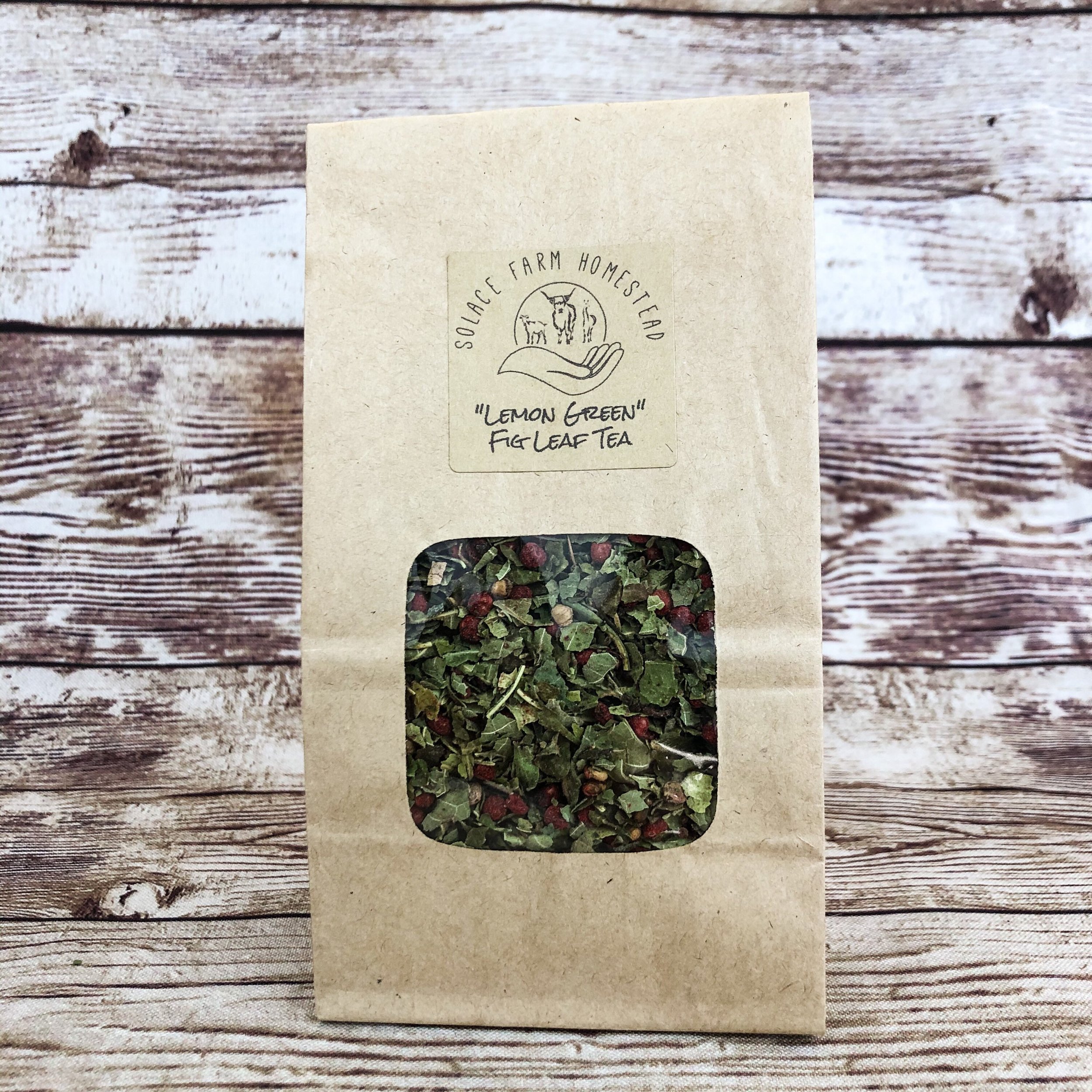 Image 1 of 3
Image 1 of 3

 Image 2 of 3
Image 2 of 3

 Image 3 of 3
Image 3 of 3




Fig Leaf + Sumac Berry Herbal Tea - Homegrown and Foraged Tisane in 2 Oz Metal Tin or Paper Refill Bag
from $14.00
Fig leaf tea has a taste similar to green tea, but naturally decaffeinated, and with notes of coconut, floral, and honey, especially when sweetened. We add wildcrafted sumac berries for a lemony pop, a pseudo- "lemon green tea" if you will.
This tea is grown in our hoop-house, and allowed to dry naturally on the plant. At frost, the leaves wilt and dry on the trees, and we collect them by hand, make sure they are dry in our solar food dehydrator, and store them airtight for use the rest of the year. We prefer the taste of the naturally-frost-dried leaves over picking them green and drying them - for lack of a better comparison I think of it as a hay-type flavor compared to green grass. Both are pleasant, but we find the naturally dried version to have a softer, warmer, more mellow flavor. We forage the sumac berries in the fall as well, when the berries have ripened but before the flavor is washed away with fall/winter rains. Sumac is extremely high in antioxidants including Vitamin C, and has a robust sour lemon-type flavor widely used in ethnic cuisines including Indian, Mediterranean, and Middle Eastern (it is one of the main ingredients in za'atar seasoning).
We use organic practices for our figs and everything else we grow here, and have been Certified Naturally Grown in the past - we have let our certification lapse as we move away from vegetable production, but we still follow organic practices in all our growing.
This tea is grown in our hoop-house, and allowed to dry naturally on the plant. At frost, the leaves wilt and dry on the trees, and we collect them by hand, make sure they are dry in our solar food dehydrator, and store them airtight for use the rest of the year. We prefer the taste of the naturally-frost-dried leaves over picking them green and drying them - for lack of a better comparison I think of it as a hay-type flavor compared to green grass. Both are pleasant, but we find the naturally dried version to have a softer, warmer, more mellow flavor. We forage the sumac berries in the fall as well, when the berries have ripened but before the flavor is washed away with fall/winter rains. Sumac is extremely high in antioxidants including Vitamin C, and has a robust sour lemon-type flavor widely used in ethnic cuisines including Indian, Mediterranean, and Middle Eastern (it is one of the main ingredients in za'atar seasoning).
We use organic practices for our figs and everything else we grow here, and have been Certified Naturally Grown in the past - we have let our certification lapse as we move away from vegetable production, but we still follow organic practices in all our growing.
Style:
Quantity:
Add To Cart
Fig leaf tea has a taste similar to green tea, but naturally decaffeinated, and with notes of coconut, floral, and honey, especially when sweetened. We add wildcrafted sumac berries for a lemony pop, a pseudo- "lemon green tea" if you will.
This tea is grown in our hoop-house, and allowed to dry naturally on the plant. At frost, the leaves wilt and dry on the trees, and we collect them by hand, make sure they are dry in our solar food dehydrator, and store them airtight for use the rest of the year. We prefer the taste of the naturally-frost-dried leaves over picking them green and drying them - for lack of a better comparison I think of it as a hay-type flavor compared to green grass. Both are pleasant, but we find the naturally dried version to have a softer, warmer, more mellow flavor. We forage the sumac berries in the fall as well, when the berries have ripened but before the flavor is washed away with fall/winter rains. Sumac is extremely high in antioxidants including Vitamin C, and has a robust sour lemon-type flavor widely used in ethnic cuisines including Indian, Mediterranean, and Middle Eastern (it is one of the main ingredients in za'atar seasoning).
We use organic practices for our figs and everything else we grow here, and have been Certified Naturally Grown in the past - we have let our certification lapse as we move away from vegetable production, but we still follow organic practices in all our growing.
This tea is grown in our hoop-house, and allowed to dry naturally on the plant. At frost, the leaves wilt and dry on the trees, and we collect them by hand, make sure they are dry in our solar food dehydrator, and store them airtight for use the rest of the year. We prefer the taste of the naturally-frost-dried leaves over picking them green and drying them - for lack of a better comparison I think of it as a hay-type flavor compared to green grass. Both are pleasant, but we find the naturally dried version to have a softer, warmer, more mellow flavor. We forage the sumac berries in the fall as well, when the berries have ripened but before the flavor is washed away with fall/winter rains. Sumac is extremely high in antioxidants including Vitamin C, and has a robust sour lemon-type flavor widely used in ethnic cuisines including Indian, Mediterranean, and Middle Eastern (it is one of the main ingredients in za'atar seasoning).
We use organic practices for our figs and everything else we grow here, and have been Certified Naturally Grown in the past - we have let our certification lapse as we move away from vegetable production, but we still follow organic practices in all our growing.
Fig leaf tea has a taste similar to green tea, but naturally decaffeinated, and with notes of coconut, floral, and honey, especially when sweetened. We add wildcrafted sumac berries for a lemony pop, a pseudo- "lemon green tea" if you will.
This tea is grown in our hoop-house, and allowed to dry naturally on the plant. At frost, the leaves wilt and dry on the trees, and we collect them by hand, make sure they are dry in our solar food dehydrator, and store them airtight for use the rest of the year. We prefer the taste of the naturally-frost-dried leaves over picking them green and drying them - for lack of a better comparison I think of it as a hay-type flavor compared to green grass. Both are pleasant, but we find the naturally dried version to have a softer, warmer, more mellow flavor. We forage the sumac berries in the fall as well, when the berries have ripened but before the flavor is washed away with fall/winter rains. Sumac is extremely high in antioxidants including Vitamin C, and has a robust sour lemon-type flavor widely used in ethnic cuisines including Indian, Mediterranean, and Middle Eastern (it is one of the main ingredients in za'atar seasoning).
We use organic practices for our figs and everything else we grow here, and have been Certified Naturally Grown in the past - we have let our certification lapse as we move away from vegetable production, but we still follow organic practices in all our growing.
This tea is grown in our hoop-house, and allowed to dry naturally on the plant. At frost, the leaves wilt and dry on the trees, and we collect them by hand, make sure they are dry in our solar food dehydrator, and store them airtight for use the rest of the year. We prefer the taste of the naturally-frost-dried leaves over picking them green and drying them - for lack of a better comparison I think of it as a hay-type flavor compared to green grass. Both are pleasant, but we find the naturally dried version to have a softer, warmer, more mellow flavor. We forage the sumac berries in the fall as well, when the berries have ripened but before the flavor is washed away with fall/winter rains. Sumac is extremely high in antioxidants including Vitamin C, and has a robust sour lemon-type flavor widely used in ethnic cuisines including Indian, Mediterranean, and Middle Eastern (it is one of the main ingredients in za'atar seasoning).
We use organic practices for our figs and everything else we grow here, and have been Certified Naturally Grown in the past - we have let our certification lapse as we move away from vegetable production, but we still follow organic practices in all our growing.
